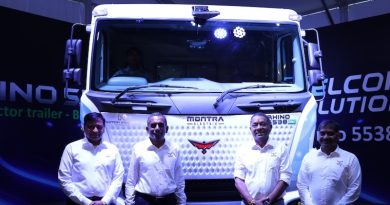Battery swapping at kirana-shop level: How tier-2 & 3 towns can rapidly support the e-CV market by 2030
Electric commercial vehicles (e-CVs), last-mile delivery vans, 1.5-4.5T small trucks, light goods carriers and three-wheelers — present a massive decarbonisation and productivity opportunity for India’s logistics backbone. For Tier-2 and Tier-3 towns, the key barrier is operational uptime: fleet operators need predictable range and fast turnarounds, but public fast-charging rollouts are slow and parked vehicles often have no safe place to charge.
Battery swapping — delivered at neighbourhood kirana shops and small garages — can crack that problem, reduce upfront vehicle cost (battery-as-a-service), and enable rapid e-CV adoption across smaller towns by 2030, says Satyendra Pal in this article. Evidence and pilots show this is feasible; the challenge is to scale it with smart policy, interoperable tech and commercially viable operator models.
Why kirana-level swapping fits Tier-2/3 India
1. Hyperlocal density, low capital footprint. Kirana stores and small garages are ubiquitous in smaller towns — they provide electricity, human presence, and a commercial anchor that can host a small battery locker or swap kiosk with minimal land cost. Early experiments in India, international models (Gogoro/Taiwan), and local pilots show that kirana-style outlets can deliver high convenience with low deployment costs.
2. Fleet economics & uptime. For fleet operators (delivery, kirana-to-consumer, milk/logistics), time off-route results in lost revenue. A 3-5-minute swap versus hours to charge makes swapping compelling — especially when bundled with battery-as-a-service (BaaS) to cut vehicle capital cost.
3. Street-parked vehicles & energy access. Many light eCVs and three-wheelers lack private parking with charging. Swapping decouples the vehicle from the stationary charging infrastructure and shifts charging to centralised depots or off-peak schedules.
What a kirana swap network looks like (practical model)
- Kirana swap kiosk: a small locker/shelf with 2–6 hot-swap batteries, a simple mechanical or semi-automated swap interface, and a tablet/QR for transactions and BMS handshake.
- Micro-hub (town level): One or two larger battery banks (50–200 kWh total) for evening replenishment and grid management.
- Back-end: Cloud BMS for battery health, SOC reconciliation, dynamic pricing, and route analytics. The local kirana owner receives a revenue share per swap and a small leasing fee for hosting.
Business models that will work in Tier-2/3
1. BaaS (Battery as a Service): Vehicle sold without a battery (or with a small buffer battery); operator subscribes monthly for batteries and swaps. Lowers vehicle CAPEX and creates recurring revenues for BSOs (Battery Service Operators).
2. Franchise + aggregator model: National/local swap operator partners with last-mile aggregators and assigns kirana owners as franchisees; aggregator fleets get guaranteed service levels. Examples in India already use franchises for urban rollouts.
3. Utility/retailer hybrid: Oil companies, utilities or supermarkets convert small forecourts or shop corners into swap points – combining fuel retailing footfall with swapping.
Technology & standardisation are non-negotiable
- Interoperability: Without battery and connector standards across eCV classes, fragmentation will kill scale. National/industry standards, or an open modular form factor for small commercial batteries, are essential.
- Safe, ruggedised batteries: Swappable packs must be engineered for many cycles, easy handling, and weatherproofing for outdoor kirana setups.
- Digital stack: Real-time BMS, swap accounting, and remote diagnostics to protect assets and ensure fair battery health accounting.
Policy & regulation (what government action accelerates 2030 scale-up)
1. Clear technical & safety guidelines. The Ministry of Power and central guidelines for swap station installation and operation (published recently) create the regulatory certainty needed for investors and utilities. These guidelines should be extended with battery pack form-factor recommendations for light commercial segments.
2. Targeted capex/subsidy for swap servers in Tier-2/3. Instead of blanket incentives for chargers, targeted support for micro-swap hubs and first-mile kirana onboarding will lower early capex hurdles.
3. Standards for interoperability & warranty rules. Mandate minimal interchangeability and battery performance standards to protect fleets and enable secondary markets.
Roadmap to 2030 — phased roll-out (practical, milestone-based)
- 2025-2026 (Pilot & proof): Focus on 20-50 towns per state; pilot partnerships with one aggregator, 100–500 swaps/day per town; refine kiosk form factor and BaaS pricing. Leverage pilots by Sun Mobility, Battery Smart and local startups for tech transfer.
- 2027–2028 (Scale & standardise): Standardise connectors/form factors for 1.5–4.5T eCVs; onboard kirana franchise network; utility-led microgrid linking for off-peak charging. Demonstrate sub-2-minute swap and 99% SLA for fleet customers.
- 2029–2030 (Network saturation): Dense town-level network with swap kiosks <1–2 km for fleet routes, integrated payments, and circular battery reuse plans (second-life, recycling). Achieve mass fleet confidence, large OEMs offer swap-compatible eCVs as an option.
Market studies project the Indian battery swapping market to grow strongly through the decade, provided that standards and business models align to support this scale.
Commercial & environmental upside
- Lowered vehicle cost: BaaS can reduce eCV sticker price substantially, accelerating fleet purchases. Pilot economics show noticeably shorter payback when uptime gains are valued.
- Grid & renewable synergy: Centralized battery pools can be charged off-peak and absorb variable renewable output, lowering emissions intensity.
- Circularity: Central management simplifies battery health tracking and secondlife redeployment — improving lifecycle sustainability.
Risks & mitigations
- Fragmentation: Multiple incompatible systems create stranded assets. Mitigation: national standardization and B2B roaming agreements.
- Capital intensity & working capital: Batteries and swap depots are capital heavy. Mitigation: blended finance-utility, public capex, and franchise partner equity; leasing models for batteries.
- Customer trust in battery health: Fleet operators worry about degraded batteries. Mitigation: transparent BMS reporting, warranties, and performance-based contracts.
Quick case examples & signals from the market
- Sun Mobility and other large players continue to expand swap tech into heavier vehicles and regional markets, attracting fresh investment and partnerships.
- Battery Smart, Yulu, Bounce and others show urban swaps work at scale-the kirana model is simply the next step for smaller towns.
Policy ask (short list for central & state governments)
1. Fast-track small-swap kiosks in EV policy roadmaps and offer capex grants for Tier-2/3 pilots.
2. Publish a light-commercial battery form-factor guideline and interoperability mandate.
3. Enable favourable electricity tariffs for swap microhubs (off-peak charging) and simplify permission for kirana-hosted swap lockers.
Conclusion – A vision for 2030
Battery swapping at the kirana-shop level is not a fanciful idea -it’s a pragmatic, near-term route to unlock eCVs across India’s Tier-2 and Tier-3 towns. With proven pilots, growing investor interest and new government guidelines, the elements are converging. The next three years (2025–2028) are decisive: build standardized kiosks, prove BaaS economics with fleets, and train a franchise network of kirana hosts. If industry, utilities and policymakers coordinate on standards, financing and local execution, battery swapping can be a major lever to meet India’s eCV penetration goals by 2030 — reducing costs, increasing uptime, and putting clean transport into the hands of small-town fleet operators.
About the author

Satyendra Pal
EV Mobility Enthusiast | Enabling Sustainable Transport |DGM-Sales & Marketing, Evall Mobility Ltd
Also read: Financing models driving electric commercial vehicle (e-CV) penetration in India
Subscribe today for free and stay on top of latest developments in EV domain.






